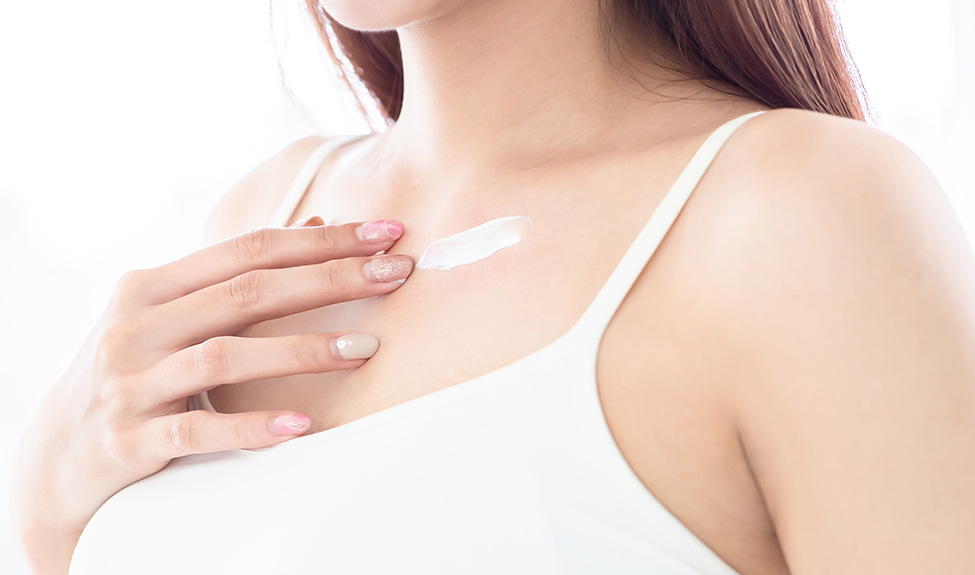A daily skincare routine – no matter how simple – is the key to keeping your skin healthy and radiant. The skin renews itself constantly, shedding dead cells to make way for new cells. Without regular cleansing and exfoliation, those cells build up on the skin’s surface, leading to dull skin tone, clogged pores, and an increased risk for acne breakouts.
When it comes to caring for their skin, clients often focus on the face, and rightly so. The skin on the face is particularly sensitive to the sun and other environmental aggressors which can accelerate the aging process. In focusing on the face, however, many clients neglect to care for the equally delicate skin on the neck, shoulders, back, and chest – the decolletage.
While facial skin can bely your age, the decolletage is actually one of the first areas of skin to show signs of aging. As a skincare professional, it’s your job to educate your clients on the importance of comprehensive skincare and to give the decolletage a little extra attention during treatments.
Why is Decolletage Care Important?
The term décolleté refers to the delicate skin on the neck, shoulders, and upper chest and back. The term comes from a French word describing the low neckline of a woman’s dress. It is often used interchangeably with “decolletage,” though some skincare professionals suggest the term “décolleté” refers specifically to the front of the chest, neck, and shoulders.
Regardless of what term you use to describe it, the skin on this part of the body tends to be thinner and more delicate than the skin on the face and the rest of the body. The skin on the neck and chest doesn’t contain as many sebaceous glands as the skin on the face, so it may be more prone to dryness. Because the skin in this area tends to be dryer, it may show the visible signs of aging more noticeably than the face. Dry, dehydrated skin shows fine lines and wrinkles more than normal or even oily skin.
While the skin on the décolleté is often neglected, it deserves the same degree of care as the skin on the face – especially during a professional treatment. It may not always be as visible as the face, depending on the client’s clothing choices, but it’s still prone to sun exposure and other environmental damage.
Tips for Treating a Client’s Decolletage
One of the first (and most important) steps in any skincare treatment is the skin analysis. Not only is it important to identify the client’s skin type for the sake of choosing appropriate products, but it’s the perfect time to evaluate the health of the client’s skin as a whole. It’s when you have a chance to talk to your client about their individual skin concerns.
While the skin analysis is generally focused on the face, don’t forget to give the decolletage a glance as well. The skin on the neck and chest is thinner and more prone to dehydration than the skin on the face.
Here are a few things to keep in mind when treating a client’s decolletage:
- Be careful when cleansing the skin on the decolletage and avoid applying too much pressure or friction when removing the product.
- Use gentle, circular motions when exfoliating the décolleté. Choose a gentler exfoliant than you would for the face and thoroughly remove the product when finished.
- Consider using a moisturizer or serum formulated for dry or mature skin on the decolletage, even if the client is younger. The décolleté is prone to moisture loss, so hydration is essential.
- Avoid using strong chemical peels on the decolletage – consider a hydrating mask for this area instead when applying facial treatments that need time to set.
- Always patch test new products before applying them to the décolleté, especially if you haven’t already tested them on the client’s face.
- Complete every facial treatment by applying sun protection. While SPF 30 or higher is recommended for the face, an SPF 50 isn’t a bad choice for the delicate decolletage.
If your client is new to professional skincare, they may not understand the importance of décolleté care. It never hurts to warn the client that you’ll be applying product to neck and upper chest as well as the face, just in case they aren’t comfortable with it. Every element of a professional skin treatment should be catered to the client’s needs and preferences.
What About At-Home Maintenance?

Product recommendations are a key element in any spa treatment, but they should be thoughtfully tailored to the client’s needs and preferences. The good news is that clients can generally use the same products on the face, neck, and chest. That being said, clients with particularly sensitive skin should exercise caution when applying products to the décolleté for the first time.
If your client is interested in dedicating a little more time and effort to décolleté care, a hydrating moisturizer is a great place to start. Products that contain hyaluronic acid are a good choice because they not only hydrate the skin but also improve its ability to retain moisture. These products have also been shown to reduce the visibility of fine lines and wrinkles.
Recommendations for cleansing and exfoliation of the décolleté may differ from the face. It’s important to be careful with the thin, delicate skin on the neck and chest, so a client may need to use a milder cleanser and a more delicate exfoliant. When it comes to exfoliation of the decolletage, clients should be encouraged to start slowly with once or twice weekly applications to see how the skin handles it.
Every component of a professional facial treatment is an opportunity to educate and guide your clients toward healthy skincare habits. By teaching your clients about the importance of decolletage care, you can help them avoid developing wrinkles and sun damage that can be difficult to repair later.

